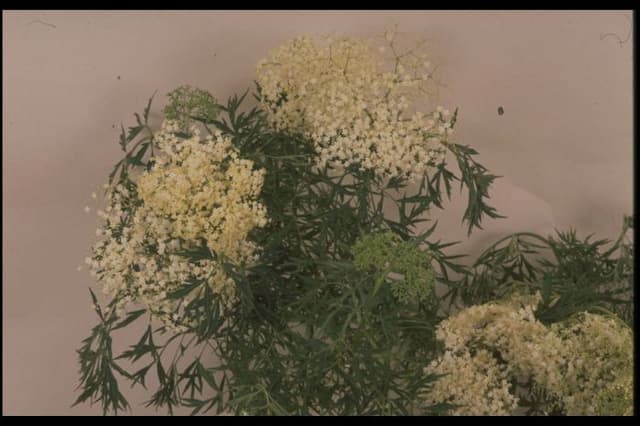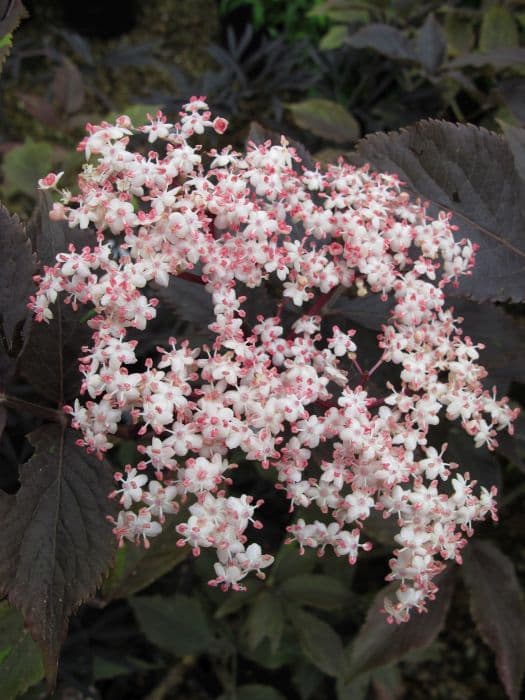Mohican Wayfaring Tree Viburnum lantana 'Mohican'

ABOUT
The plant known as Mohican Viburnum is a dense, multi-stemmed shrub recognizable by its rich green foliage. The leaves have a slightly wrinkled texture with a broad, oval shape that comes to a point at the tip, giving them an attractive appearance. In spring, it produces creamy-white flowers clustered in dome-shaped groupings. It's well-known for its delightful floral display that is both visually appealing and fragrant. As the seasons change, the Mohican Viburnum showcases its versatility in the landscape. Following the flowering period, it bears fruit that initially appears as red berries. These berries mature to a black color over time. This fruit is not only a visual feature but also serves as a food source for birds and wildlife. The shrub's foliage brings additional seasonal interest as the leaves transition to a striking burgundy color in the fall. The overall appearance of the Mohican Viburnum is robust and full, with a naturally rounded shape that provides a sense of lushness in garden settings. Its ability to produce a significant ornamental impact without detailed pruning makes it a low-maintenance option for gardeners looking to add a year-round aesthetic appeal to their green spaces.
About this plant
 Names
NamesFamily
Adoxaceae.
Synonyms
Wayfaring Tree, Mohican Viburnum.
Common names
Viburnum lantana 'Mohican'.
 Toxicity
ToxicityTo humans
Mohican Wayfaring Tree is generally regarded as having only mild toxicity to humans. Although severe reactions are rare, ingestion can potentially cause mild stomach upset, including symptoms like nausea, vomiting, and diarrhea. As with any plant considered to have toxic properties, it is advisable to avoid ingesting any parts of the plant.
To pets
Mohican Wayfaring Tree could be toxic to pets if ingested. Similar to its effects in humans, the plant can cause mild symptoms, which may include vomiting, diarrhea, and drooling. While it is not considered highly toxic, ingestion of the berries, leaves, or other parts of the plant should be avoided to prevent any potential discomfort or adverse reactions in pets. If a pet ingests a considerable amount, it's recommended to consult a veterinarian.
 Characteristics
CharacteristicsLife cycle
Perennials
Foliage type
Deciduous
Color of leaves
Green
Flower color
White
Height
7 feet (2.13 meters)
Spread
9 feet (2.74 meters)
Plant type
Shrub
Hardiness zones
4
Native area
Europe
Benefits
 General Benefits
General Benefits- Ornamental Value: The Mohican viburnum offers year-round visual interest, with springtime flowers, summer berries, and colorful fall foliage.
- Wildlife Attraction: Its berries provide a food source for birds and its foliage offers shelter for various wildlife.
- Drought Tolerance: Once established, the Mohican viburnum is tolerant to periods of low water availability, making it suitable for xeriscaping.
- Low Maintenance: There is generally no need for frequent pruning or complex care routines.
- Pest Resistance: The Mohican viburnum is notable for its resistance to many common pests that affect other garden plants.
- Hedge and Privacy Screen: It can be used to create dense hedges or privacy screens in landscaping designs.
 Medical Properties
Medical PropertiesThis plant is not used for medical purposes.
 Air-purifying Qualities
Air-purifying QualitiesThis plant is not specifically known for air purifying qualities.
 Other Uses
Other Uses- Insect habitat: Viburnum lantana 'Mohican' can provide a protective habitat for beneficial insects, offering a place for pollinators like bees and butterflies to rest and feed.
- Bird food source: The berries produced by the plant can serve as a food source for birds, especially in the fall and winter when other food sources are scarce.
- Privacy screens: Due to its dense growth habit, it can be used to create privacy screens or hedges in residential and commercial landscapes.
- Windbreaks: When planted in rows, Viburnum lantana 'Mohican' can act as a windbreak, protecting gardens and structures from strong winds.
- Erosion control: Its root system can help stabilize soil on slopes and prevent erosion.
- Foundation planting: The shrub's manageable size and attractive foliage make it suitable for planting near buildings to hide foundations and create visual interest.
- Focal point in garden design: With its showy flowers and berries, Viburnum lantana 'Mohican' can serve as an eye-catching focal point in a garden or landscape design.
- Sound barrier: The dense foliage can help absorb sound, making it ideal for planting along roadways or between properties to reduce noise pollution.
- Textural contrast: Its leaves can be used in landscape designs to provide textural contrast with plants that have finer or more delicate foliage.
- Seasonal interest: Offering spring flowers, summer berries, and autumn foliage color, Viburnum lantana 'Mohican' can be used to provide year-round interest in the landscape.
Interesting Facts
 Feng Shui
Feng ShuiThe Wayfaring Tree is not used in Feng Shui practice.
 Zodiac Sign Compitability
Zodiac Sign CompitabilityThe Wayfaring Tree is not used in astrology practice.
 Plant Symbolism
Plant Symbolism- Renewal: Viburnum in general is a symbol of renewal and optimism, as many species bloom early in spring, reminding people of the cycle of rebirth and new beginnings.
- Protection: The dense and hardy nature of the Wayfaring Tree, with its sturdy branches, can symbolize protection and shelter.
- Family and Fertility: With its prolific flowering and fruiting habits, the Wayfaring Tree may represent the concepts of family and fertility.
 Water
WaterThe Mohican Viburnum should be watered deeply with around 2 gallons of water per week during the first growing season to establish a deep, extensive root system. Once established, they are quite drought tolerant and will require less frequent watering, depending on weather conditions. During dry spells or extreme heat, increase watering to once a week, ensuring the soil becomes moist but not soggy, promoting healthy root growth. For mature plants, reduce the amount to about 1 gallon every two weeks, unless conditions are very dry.
 Light
LightFor the Mohican Viburnum, the best light conditions include full sun to partial shade. It will thrive when it receives at least 6 hours of direct sunlight daily but can also perform well in areas that receive light shade for part of the day. Planting the Mohican Viburnum in a spot with morning sunlight and afternoon shade can protect it from the harsh midday sun, especially in hotter climates.
 Temperature
TemperatureThe Mohican Viburnum is adaptable to a wide range of temperatures but grows best when the environment is between 60°F and 75°F. It can survive winter temperatures as low as -10°F but is susceptible to damage if the temperatures dip below this. It should be protected from extreme heat above 95°F, which may stress the plant, especially if accompanied by drought conditions.
 Pruning
PruningPrune the Mohican Viburnum immediately after its flowers fade in late spring to early summer to shape the plant and encourage vigorous growth. Pruning is not only for aesthetic purposes but also promotes good air circulation within the plant, which can reduce the risk of disease. It's best to remove up to one-third of the oldest stems to encourage new growth and maintain a healthy plant structure. Selective pruning every year should maintain the desired shape and size.
 Cleaning
CleaningAs needed
 Soil
SoilThe Wayfaring Tree prefers well-drained soil with high organic content and a pH range between 5.6 and 7.5. To create an optimal soil mix for this shrub, combine garden soil, compost, and peat moss in a ratio of 2:1:1 to ensure fertility and good drainage.
 Repotting
RepottingWayfaring Trees are large shrubs and typically do not require repotting as they are usually planted directly in the ground. Rather than repotting, it is best to replenish the surrounding soil with compost yearly.
 Humidity & Misting
Humidity & MistingWayfaring Tree is adaptable to a range of humidity conditions and thrives in average outdoor humidity without the need for special attention regarding ambient moisture.
 Suitable locations
Suitable locationsIndoor
Place Wayfaring Tree in bright, indirect light; ensure it's cool in winter.
Outdoor
Plant Wayfaring Tree in sun or partial shade; shelter from strong winds.
Hardiness zone
4-8 USDA.
 Life cycle
Life cycleThe life cycle of the Viburnum lantana 'Mohican', commonly known as the Mohican Wayfaring Tree, begins with seed germination, which is highly reliant on adequate chilling periods for dormancy break. Once germinated, the seedling develops into a young plant, gradually maturing over several years to a multi-stemmed shrub. The Mohican Wayfaring Tree reaches reproductive maturity after a few years, at which point it produces fragrant white flowers in late spring that are attractive to pollinators. Following pollination, these flowers give way to clusters of reddish-black drupes (berries) that mature by late summer and are consumed by birds and wildlife. Throughout its life, the shrub undergoes an annual cycle of growing new leaves in the spring, which are dark green and oval, and then these leaves turn to a purple-red color before falling in the autumn. The plant has a long lifespan, with individual shrubs being able to thrive for decades under suitable conditions.
 Propogation
PropogationPropogation time
Spring-Early Summer
The most popular method of propagating Viburnum lantana 'Mohican', commonly known as Wayfaring Tree, is by softwood cuttings. This technique is often conducted in late spring or early summer when new growth is still flexible but has begun to mature. To do this, a gardener would cut a 4 to 6 inch (10 to 15 cm) piece from the current year's growth, making sure that there are at least a couple of leaves attached. The lower end of the cutting should be dipped in rooting hormone to encourage root growth before it is planted in a well-draining soil mix. The cutting should then be kept moist and in a warm, shaded location until roots develop which generally takes a few weeks.









